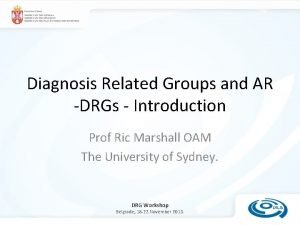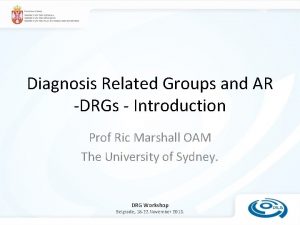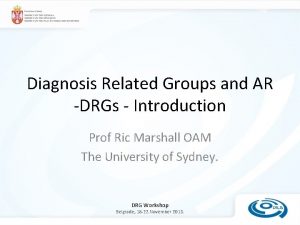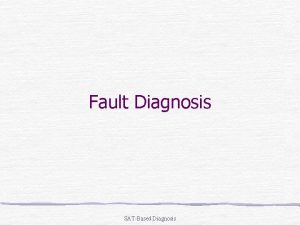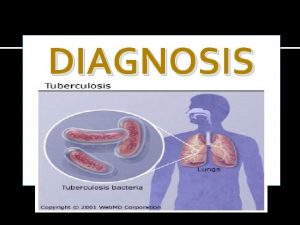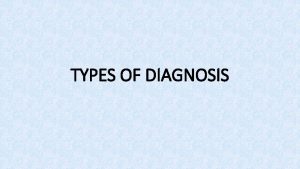DIAGNOSIS RELATED GROUPS DRGs PENGERTIAN Diagnosis Related Groups









- Slides: 9

DIAGNOSIS RELATED GROUPS (DRG’s)

PENGERTIAN Diagnosis Related Groups (DRGs) represent an inpatient classification scheme to categorize patients who are medically related with respect to diagnoses and treatment, who are statistically similar in their lengths of stay

DRG assignment is usually performed by a computer with grouper software, but may be performed manually utilizing the decision trees and listings of OR procedures, complications, and comorbidities

• Principal Diagnosis The principal diagnosis is defined as the condition which after study, was found to be chiefly responsible for occasioning the patient’s admission to the hospital for care. Only one DIAGNOSIS may be listed as the Principal Diagnosis.

• Secondary Conditions All conditions should be listed that: 1. existed at the time of patient’s admission to hospital for which treatment was given, or 2. that arose during the patient’s stay in hospital, or 3. that affected the patient’s treatment and/or LOS by greater than one day.

COMPLICATION An Additional Diagnoses that described a Condition arising after the beginning of Hospital Observation and Treatment and MODIFYING the course of the Patient’s Illness or The Medical Care Required. KOMPLIKASI MEMILIKI ARTI SEMPIT APABILA: - It describes an undesired result or misadventure in medical care of hospital patient. Such as: - decubitus ulcer - post-op hemorrhage - adverse effect of medicinal agent - hospital acquired infection (Nosocomial) - surgical emphysema, etc.

KOMPLIKASI MEMILIKI ARTI LUAS APABILA: • It denotes any condition concurrent with the Condition described in the Principal Diagnosis regardless of the time of it’s onset. MOST SIGNIFICANT DIAGNOSIS • The one Diagnosis, often but not necessarily the Principal Diagnosis that describes the most Important or Significant condition of a Patient in term of its Implications for his/hers health care, his/hers use of the Hospital

ASURANSI KESEHATAN MEMBEDAKAN SECARA TEGAS ANTARA: • COMPLICATION: complication is a condition that arises during the Hospital Stay that PROLONGS the patient’s L. O. S. by at least ONE day in 75% of the cases. • COMORBIDITY is a PRE-EXISTING condition that will, because or it’s presence with a specific Principal Diagnosis cause an increase in the Patient’s L. O. S by at least ONE day in 75% of the cases

MAJOR DIAGNOSTIC CATEGORY (MDC) 12 Diseases and disorders of the Male Reproductive System Yes Surgical Partitioning Major Pelvic 334 CC No OR Procedure Yes 335 Penis 341 Yes Transurethal Prostatectomy No OR Procedures Medical Partitioning Principal Diagnosis 336 Age>69 and/or CC No Other Male Reproductive System Malignancy Benign Prostatic Hypertrophy 337 Yes Principal Diagnosis Malignancy Age>69 and/or CC No Yes No Inflammation Sterilization Other Male Reproductive System Diagnoses CC = Complication and/or Comorbidity DRG 344 345 346 347 348 349 350 351 352
 A computer software program that assign appropriate ms-drgs
A computer software program that assign appropriate ms-drgs How are ethnic groups and religious groups related
How are ethnic groups and religious groups related Nursing diagnosis examples
Nursing diagnosis examples Medical diagnosis and nursing diagnosis difference
Medical diagnosis and nursing diagnosis difference Medical diagnosis and nursing diagnosis difference
Medical diagnosis and nursing diagnosis difference Medical diagnosis and nursing diagnosis difference
Medical diagnosis and nursing diagnosis difference Perbedaan diagnosis gizi dan diagnosis medis
Perbedaan diagnosis gizi dan diagnosis medis Grief nursing diagnosis
Grief nursing diagnosis Physical fitness is of two types
Physical fitness is of two types Skill and health related
Skill and health related










